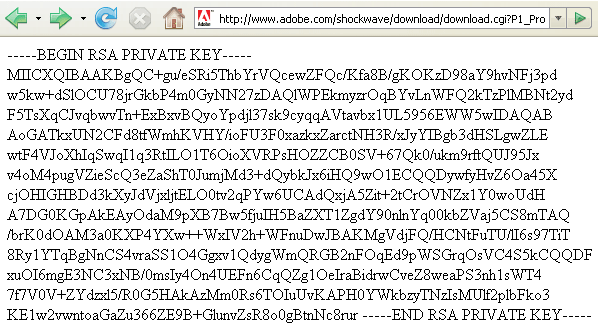Posted by: Samker
« on: 30. September 2007., 03:03:52 »Directory traversal shocker
A scripting error in Adobe's website gave outsiders broad access to internal files on the company's webserver that could prove valuable to malicious hackers trying to penetrate its security.
The error, which appeared to reside in a faulty CGI script, allowed people outside Adobe to read and download files entering specially crafted URLs into their favorite browser. An Adobe spokesman said company engineers have plugged the leak, but couldn't say when or how long the error had exposed site internals.
The flaw, known as a directory traversal, has serious implications for the security of Adobe's site because it effectively gave web surfers the same permissions to read files afforded Adobe's web application. Online discussions, including this one from Reddit contained numerous posts claiming the private key Adobe uses to authenticate itself during Secure Socket Layer sessions was exposed. The interception of the key could make it easier for malicious hackers to spoof trusted portions of Adobe's site.
Indeed, plugging this address into Firefox produced the output pictured below, which appears to be the private key corresponding to www.adobe.com.

Company spokesman Stefan Offermann said the key was "self-signed" and used for internal purposes only and that the key for www.adobe.com was never exposed. At no time was confidential customer information accessed, he added. Offermann was unable to say if the internal key had been revoked or whether private keys for other Adobe web properties might have been leaked.
Beyond Adobe's private key, the snafu had the potential to expose other sensitive files, including Perl, Java or .Net scripts used by the site to upload files or carry out other requests made by visitors.
"You can read any file on their server that the web application has permission to read," said Charlie Miller, principal security analyst for Independent Security Evaluators, which regularly audits websites for these types of errors. "Depending on the type, you could grab the web application itself. Either one would help in discovering new vulnerabilities."
Exploiting the Adobe vulnerability was as simple as injecting a series of strings containing the text "../" in them along with the locations of sensitive files used in standard Unix environments. The string "../" tells Unix to jump to the file directory just above the current one, so the link shown above - which when spelled out is...
http://www.adobe.com/shockwave/download/download.cgi?P1_Prod_Version
=../../../../../../../../..//usr/local/apache/conf/ssl.key/www.adobe.com.key%00
...(emphasis added) - prompted Adobe's web application to jump to the root directory and then read a file called www.adobe.com.key located in the /usr/local/apache/conf/ssl.key directory.
Despite awareness of the error dating back more than seven years, it's one that webmasters continue to make. Says Robert Hansen, CEO of secTheory.com: "This is a really common vulnerability in Perl and PHP that novice programmers make a lot. It still plagues a lot of websites and allows an attacker to gather a lot more data than they would from the operating system."
(Copyright by The Register)
http://www.theregister.co.uk/2007/09/27/adobe_website_leak/
A scripting error in Adobe's website gave outsiders broad access to internal files on the company's webserver that could prove valuable to malicious hackers trying to penetrate its security.
The error, which appeared to reside in a faulty CGI script, allowed people outside Adobe to read and download files entering specially crafted URLs into their favorite browser. An Adobe spokesman said company engineers have plugged the leak, but couldn't say when or how long the error had exposed site internals.
The flaw, known as a directory traversal, has serious implications for the security of Adobe's site because it effectively gave web surfers the same permissions to read files afforded Adobe's web application. Online discussions, including this one from Reddit contained numerous posts claiming the private key Adobe uses to authenticate itself during Secure Socket Layer sessions was exposed. The interception of the key could make it easier for malicious hackers to spoof trusted portions of Adobe's site.
Indeed, plugging this address into Firefox produced the output pictured below, which appears to be the private key corresponding to www.adobe.com.

Company spokesman Stefan Offermann said the key was "self-signed" and used for internal purposes only and that the key for www.adobe.com was never exposed. At no time was confidential customer information accessed, he added. Offermann was unable to say if the internal key had been revoked or whether private keys for other Adobe web properties might have been leaked.
Beyond Adobe's private key, the snafu had the potential to expose other sensitive files, including Perl, Java or .Net scripts used by the site to upload files or carry out other requests made by visitors.
"You can read any file on their server that the web application has permission to read," said Charlie Miller, principal security analyst for Independent Security Evaluators, which regularly audits websites for these types of errors. "Depending on the type, you could grab the web application itself. Either one would help in discovering new vulnerabilities."
Exploiting the Adobe vulnerability was as simple as injecting a series of strings containing the text "../" in them along with the locations of sensitive files used in standard Unix environments. The string "../" tells Unix to jump to the file directory just above the current one, so the link shown above - which when spelled out is...
http://www.adobe.com/shockwave/download/download.cgi?P1_Prod_Version
=../../../../../../../../..//usr/local/apache/conf/ssl.key/www.adobe.com.key%00
...(emphasis added) - prompted Adobe's web application to jump to the root directory and then read a file called www.adobe.com.key located in the /usr/local/apache/conf/ssl.key directory.
Despite awareness of the error dating back more than seven years, it's one that webmasters continue to make. Says Robert Hansen, CEO of secTheory.com: "This is a really common vulnerability in Perl and PHP that novice programmers make a lot. It still plagues a lot of websites and allows an attacker to gather a lot more data than they would from the operating system."
(Copyright by The Register)
http://www.theregister.co.uk/2007/09/27/adobe_website_leak/


